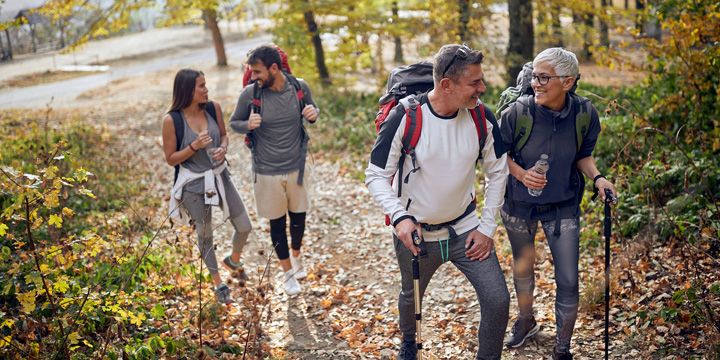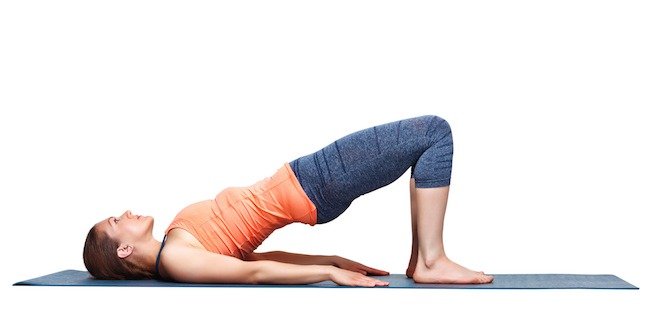
Many people with diabetes manage to follow the physical activity recommendations by staying active and exercising during the summer months but find it much harder to stay active in cold weather. Lots of people without diabetes have the same problem!
If this sounds familiar, you might find it motivating to know that exercise in the fall and winter can help boost the immune system. This means that staying physically active during the colder months could actually help protect you from colds and flu. Winter exercise can also combat seasonal lethargy and boost mood, reducing the risk of winter-related depression, often referred to as Seasonal Affective Disorder (SAD). And that’s in addition to all the other known benefits like weight management, improved insulin sensitivity and blood glucose management, and bone and muscle strengthening.
Activity ideas
Getting outside has many benefits during the colder months, so try to make sure that at least some activities are based outdoors each week.
What are some outdoor activity options for people with diabetes?
- Walking, walking and more walking: Don’t underestimate this incredible activity. You can reach your physical activity goals by heading out in almost any weather if you are dressed for it. Long underwear really does the trick! Even 10 minutes after your meals can have a big impact on your blood sugars and overall health. Opt for cleared paths or tracks with minimal ice and snow.
- Snowshoeing: Consider this low-impact, calorie-burning activity that’s easy on the joints.
- Cross-Country Skiing: This provides a full-body workout and boosts cardiovascular health.
- Shovelling Snow: If done with caution, it can be a good form of exercise, but it’s essential to monitor intensity. You may also want to check with your diabetes healthcare team, to make sure it’s an activity that is okay for you. And like any other exercise, it’s always best to warm up first before beginning. For example, walk for a few minutes before shovelling. Starting slowly and taking short breaks every 5 – 7 minutes is also a good idea. Finally, you should be sure to drink lots of water to avoid dehydration.
For those who don’t like the cold weather, here are some indoor options.
- Join a mall walking group
- Exercise at the gym
- Exercise using an online program – there are a wide variety of programs available to meet everyone’s needs and abilities
- Swim in an indoor pool
- Have fun at a bowling alley
- Enjoy rock climbing at an indoor centre
- Skate or play hockey in an arena
- Take dancing classes in person or online. Or simply turn on some great music and dance!
- Invest in some indoor exercise equipment so there is no excuse that you can’t get to the gym and can’t exercise. Even some weights, a band and a mat can make for a cost-effective home gym.
- The colder months are also a great time to get to know some of the museums or art galleries in large cities. You can walk for many miles this way!
Challenges of Exercising in Cold Weather
Despite the benefits, winter activity comes with challenges:
Blood Sugar Fluctuations
The cold can affect blood sugar levels, as the body uses more energy to stay warm. Exercise can compound these fluctuations, so monitoring is crucial.
Foot Care
Poor circulation and cold temperatures increase the risk of frostbite and foot injuries, especially if you have neuropathy.
Slippery Surfaces
Ice and snow pose risks of falls and injuries.
Motivation
The allure of staying indoors can hinder regular activity.
Safety first
If outdoor physical activity is planned, it’s important to keep in mind some safety guidelines:
- Dress for the weather. Choose waterproof coats or jackets, and be sure that ears and fingertips are covered, in addition to the head. Dress in layers. Boots should be waterproof and comfortable and have a strong non-slip tread for stability in the snow. Make sure there is room for the toes to wiggle, even when wearing warm socks.
- Monitor Blood Sugar Levels. Cold weather and exercise can both impact glucose levels, making regular monitoring essential.
- Before Exercise: Check your blood sugar to ensure it’s within a safe range for activity.
- During Exercise: If your activity lasts more than an hour, monitor your levels to detect drops.
- After Exercise: Check again to prevent delayed hypoglycemia.
Always carry fast-acting glucose, such as glucose tablets or candy, in case of hypoglycemia.
- Warm Up and Cool Down. Cold muscles are more prone to injury. Spend 5-10 minutes warming up indoors before heading out. A cool-down period indoors will also help your body adjust to temperature changes gradually.
- Stay Hydrated. Dehydration is a risk in winter because the body loses moisture even in cold weather. Drink water before, during, and after exercise to stay hydrated.
- Protect Your Skin. Cold air can dry out your skin, which is already vulnerable due to diabetes. Use a non-greasy moisturizer and cover exposed skin to avoid chapping.
- Prepare for Icy Conditions. If you have any problems with balance, a cane or walker is suggested for winter use. If this is the case, speak to your healthcare team about attaching an ice pick to the end of the cane.
When to Seek Medical Advice
Before starting a new winter fitness routine, consult your healthcare provider, especially if you have:
- Diabetes complications, such as neuropathy or retinopathy.
- A history of cardiovascular issues.
- Concerns about managing blood sugar levels during exercise.
How can you keep motivated to exercise during the winter months?
It can be really difficult to staying motivated during the winter months. Try to set realistic, achievable fitness goals to keep you on track. You may want to reach out to a friend or join a group to help make it more enjoyable. Try changing your activities to add variety to the mix so that it feels fresh and engaging. And finally, remember to reward yourself for achieving your goals!
Staying active in cold weather is crucial for managing diabetes and overall well-being. With proper planning, suitable clothing, and safe activity choices, you can enjoy the benefits of exercise while minimizing risks. Embrace the winter season as an opportunity to maintain your health, try new activities, and enhance your resilience against the cold.




